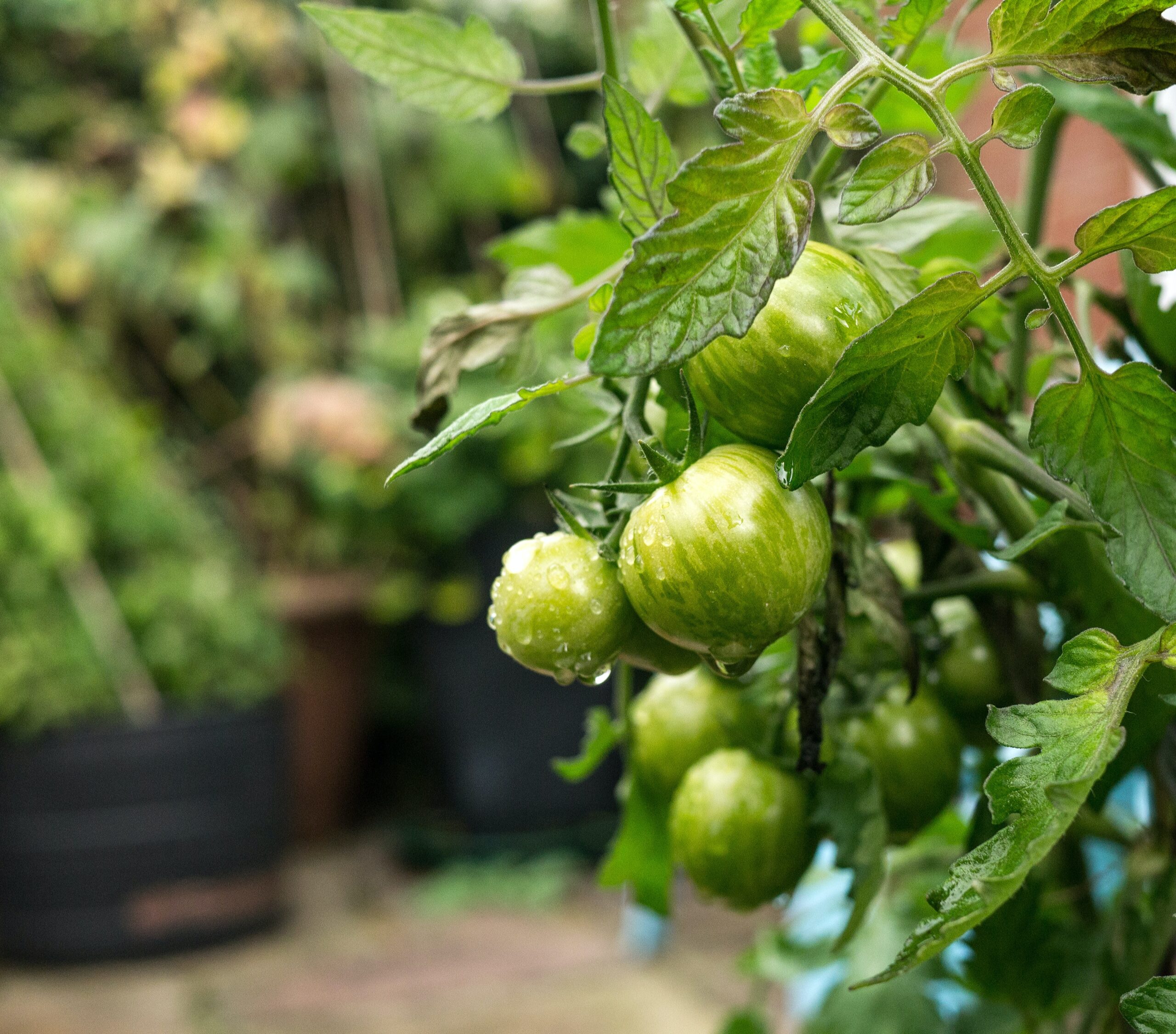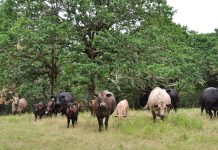Written by: DJ McCauley
“In times of crisis, people become really passionate about their food supply,” says Rachel Surls, sustainable food systems adviser for the Los Angeles County Cooperative Extension. “We saw a boom in urban agriculture during the recession in 2008, and we’re seeing it now.”
This observation isn’t confined to sunny California: Across the country, consumers are getting creative when it comes to their produce. Outlets like Forbes, CBS, and the BBC have likened the uptick of interest in gardening to a modern renaissance of wartime victory gardens. When you’re not sure grocery store shelves will have the produce you’re looking for, what better assurance than growing it yourself?
Though gardening made headlines last spring, urban farming is not a new concept. Extension agents and researchers in big cities have been running all sorts of operations for years, helping people grow nutritious food where it’s needed most.
From backyard plots to community gardens, all the way up to full-time, commercial operations supplying farmers’ markets, restaurants, and grocery stores, urban farming serves a vital role in food security, community education, and outreach.
Food Insecurity
For many people, fresh food is not a given.
The Food and Agriculture Organization of the United Nations defines food security as existing when “all people, at all times, have physical, social and economic access to sufficient, safe and nutritious food that meets their dietary needs and food preferences for an active and healthy life.”
This is not a small goal.
The U.S. Department of Agriculture (USDA) tracks access to affordable and nutritious food. According to a 2015 report, 39.4 million people in the United States have both low income and low access. That means that the nearest grocery store is more than 1 mile away in urban areas or 10 miles away in rural areas, while a low-income area is defined as one in which at least 20 percent of households are below the poverty line.
Marcus Williams, the Baltimore City Master Gardener Coordinator with the University of Maryland, laid out the struggle it takes for some residents in urban areas to get fresh food.
“It can be really hard to pack fresh food or produce across the city,” Williams says. “If you’re on a bus, it might take an hour just to get to a grocery store, and if you have kids, you’ve got to find childcare, which is another cost.”
An added layer of complexity: Many areas experienced stay-at-home orders during the pandemic. The results of that two-hour roundtrip grocery store run had to last a family even longer than usual.
Even under normal circumstances, people might be more inclined to get more convenient, premade, and less nutritious food. Some neighborhoods don’t even have a grocery store nearby, so residents rely on tiny corner stores.
“Every area has its own problems, its own obstacles to overcome,” Williams says.
Urban Agriculture
Growing food in cities is not a new idea. Archeological evidence suggests that farmers in ancient Mesopotamia and Persia set aside plots of land within cities to grow food and dispose of urban waste.
Now, the ways to engage with urban agriculture are as diverse as the people who practice it. From potted plants on a sunlit porch, to a backyard vegetable plot, to hoop houses, rooftop gardens, and commercial operations with several acres within a city, growers and gardens have become creative.
The constraints that challenge urban farmers fall into several categories: finding land, water, healthy soil, and funding. Some cities have prohibitive policies and ordinances; occasionally there’s pushback against gardens and urban agriculture. The size of each of these challenges depends on the city.
In Los Angeles, New York City, and Washington, D.C., the price of land prevents many farmers from buying their own, and vacant lots are prone to being repurposed at short notice for real estate.
In Baltimore, it’s sometimes difficult to find affordable water sources.
In Detroit, vacant land is readily available, but gaining agency of lots and rehabilitating urban soils to a productive state requires time, energy, and resources.
The scale of production varies widely, too.
“It’s one thing if you have an abundance of food from your home garden, and you think, ‘Oh, I could sell some of this!’” Surls says. “But full-time urban farmers, that’s a different story. They really have to patch it together.”
They use their grounds as wedding venues, host workout classes, and create value-added products like jam, jelly, hot sauce, or seedlings for other gardeners. Many long-standing farms are nonprofits, with educational goals or other community-driven objectives.
Regardless of scale, the challenges that face urban gardeners haven’t put them off the practice. Innovative partnerships between communities and extension agents, researchers, and growers have blossomed, yielding interesting fruit.
Tillage in Detroit
When Naim Edwards used deep tillage on one of his test plots at the Michigan State University–Detroit Partnership for Food, Learning and Innovation (DPFLI) in 2019, he found some funky stuff.
“We turned up pieces of cinder block, rebar, tiles—all kinds of construction debris that could inhibit plant root growth,” Edwards says.
It wasn’t much of a surprise since DPFLI is located on the grounds of a demolished elementary school in a residential neighborhood.
Spanning an entire city block—about 3.5 acres—DPFLI has come a long way since Michigan State University broke ground. This spring, construction was finished on the first building at the site: an educational center with a conference room and Edwards’s office. The grounds have recreation areas, test plots, fruit trees, and native plant gardens.
“We have to invest time and energy in this space to make it beautiful, so the people who walk around and through the garden want to engage with it,” Edwards says. “Local neighbors are the people we want to attract the most: the ones living right here.”
Besides engaging with the community through vegetable production, Edwards coordinates experiments in his 50-square-foot test plots. He’s testing how different methods of tillage and cover crop mixes impact soil performance. His measures include soil compaction, water infiltration rates, organic matter accumulation, and weed suppression.
Edwards’s summer 2019 report revealed that no-till plots yielded larger plants than those with tillage, and the weed suppression cover crop mix he used had the lowest weed density and species diversity compared with the other cover crop mixes.
Tillage and cover crop mixes have hardly been studied in urban soils, so foundational reports like those created by DPFLI are crucial. Edwards also strives to write the reports in accessible language.
“We’re not writing them for scientists; they’re for the average person who wants to figure out the best way to manage their garden,” Edwards says.
In Detroit, commercial urban farming operations do a great deal to make their urban soils productive again. Edwards notes that some spend $8,000–$10,000 a year on compost.
“If you’re scaling up, that’s somebody’s part-time job or a new piece of equipment,” he says.
He hopes to find more efficient ways for urban farmers to create productive soils in short amounts of time. There’s still a lot to discover.
Rainwater in Maryland
Meanwhile in Maryland, finding land to farm is straightforward, but finding affordable water? Not so much.
“We had one community garden [in Baltimore City] where a man loaded a 30-gallon barrel in the back of his pickup truck. He would drive door-to-door in his neighborhood, and people would put some tap water in the barrel,” Williams says. “They’d use that to water the garden.”
Williams has seen a big uptick in participation in the Master Gardener course he coordinates—instructors have pivoted the programming from primarily landscaping and horticultural work to vegetable crops, based on the interests of course attendees.
Williams recently partnered with another University of Maryland researcher, Rachel Goldstein, when the two met at a gathering of extension agents.
Goldstein is an assistant professor of applied environmental health, and she codirects the Extension and Outreach team of a project called Coordinating Nontraditional Sustainable Water Use in Variable Climates (CONSERVE). The team’s goal is to assess farmers’ knowledge and concerns about alternative water sources and craft outreach to match.
From this project sprung Goldstein’s Rooftop Runoff Irrigation Produce Eaten Raw (RRIPER) program. One outcropping of the project is water quality testing that Goldstein’s team is conducting using a set of raised beds built by Hood College, set up beside a homeless shelter in Frederick, Md. They’re not ordinary beds, though. Pipes collect rainwater off the roof of the shelter’s offices and funnel it through a filter and then to a holding tank. Once the holding tank is full, the excess runs to a wicking system at the base of the large raised beds. The wicking system feeds into a layered set of materials, with gravel at the base, then sand, and then soil and plant roots. The beds are lined to prevent too much water loss, and the soil layer only wicks water upward as the surface dries.
Benefits of the system are twofold: It uses free, nonpotable water for vegetable gardens, with tanks holding the excess rainwater for drier days, and it finds another use for rainwater before it becomes stormwater runoff.
In urban areas, stormwater runoff picks up all kinds of pollutants and debris that aren’t filtered through water treatment systems or the soil. Instead, runoff flows directly into storm drains and then into the nearest rivers, lakes, and eventually the ocean. Collecting rainwater as it flows off rooftops, as the Frederick system does, prevents it from running off into the environment.
Before the RRIPER team can start scaling up the system, they need to make sure the produce they grow isn’t contaminated.
“Harvested rainwater could be an amazing alternative source of water for urban farmers and community gardeners, but we have to make sure it’s safe first,” Goldstein says.
The idea is that the subsurface irrigation system will filter the water up through the soil, preventing it from contacting edible portions of the plants.
With four pilot beds, Goldstein is hopeful about the preliminary results. Along with her collaborators at the USDA Agricultural Research Service, the team tested the vegetables grown in the beds for bacterial indicators and pathogens, finding only very low levels of indicator species. No one has eaten their experimental veggies, yet—they’re gathering more data before they provide food to the community.
Goldstein and Williams are teaming up to install and test this setup in community gardens in Baltimore. With their help, soon gardeners may forgo the 30-gallon barrels and make use of an untapped resource: harvested rainwater.
Community in New York City
“Our urban agriculture looks different from anywhere else,” Yolanda Gonzalez says. “These spaces really do help with food security. If they don’t provide at least a portion of someone’s diet, then they’re being used in food box programs.”
Gonzalez is an urban agriculture specialist with Cornell Cooperative Extension, assisting commercial urban agriculture operations in New York City—more than 40 of them, at her last count.
Many commercial urban farms operate in a way totally alien to traditional agricultural setups. Often, long-term setups are nonprofits that support community health and education and provide spaces for meetings and trainings.
“Community gardens are providing food and an area for people to pick up local produce. They don’t just increase the volume of produce, they give lots of other local farms Upstate and on Long Island opportunities to distribute their food, too,” Gonzalez says.
One example of a prolific nonprofit is GrowNYC. This year marks the organization’s 50th anniversary, and it is a critical player in getting fresh, affordable food to underserved areas in the city.
GrowNYC is one of the main coordinators of the Fresh Food Box program, partially funded by the New York Department of Agriculture. By partnering with local farmers, GrowNYC can source produce for boxes that New York City residents order the week before and then pick up at a designated distribution point—often their local community gardens.
For $14, purchasers get a box of food filled with fresh vegetables for near-wholesale prices. They can add eggs, bread, or local maple syrup for an additional cost. According to Gonzalez, each base-level box is closer to $35 in value.
Another group, the Rockaway Initiative for Sustainability and Equity (RISE), is helping residents impacted by the pandemic. RISE received support from the New York Community Trust COVID-19 Emergency Fund. As a result, some Rockaway residents who are eligible based on employment status (due to the pandemic) or income are eligible to receive free produce boxes from RISE.
Finally, Gonzalez mentions that other groups like the Black Feminist Project also provide free and sliding-scale-priced food bags as part of their Corona Relief Food Box. For low-income households in the Bronx, the access the group gives to fresh, affordable produce is critical.
There’s no long-term commitment to buying these food boxes, either—consumers can opt in the week before, rather than paying a set subscription over time. This is different from the classic community-supported agriculture (CSA) model. It allows underserved individuals the flexibility to buy a box, or not, depending on their needs. These programs also accept electronic benefit transfer (EBT) and Health Bucks, besides credit, debit, and cash payment methods. Many CSAs, on the other hand, are unable to accept Supplemental Nutrition Assistance Program (SNAP) benefits.
CSAs in California
CSAs, however, have been filling the gaps in food security in California. The CSA model functions on a subscription basis: The interested consumer signs up to pay a set amount per week or month and then receives a box of produce from a local farm.
The USDA Agricultural Marketing Service hosts a site with a directory of CSAs. Consumers can use the site to filter farms based on location, products available, and payment accepted. Consumers can also find CSAs using a site called Local Harvest.
“In California, we saw CSA subscriptions jump when the pandemic started,” Surls says. “They often provide add-ons like eggs or bread or other value-added products. When we had that egg shortage, people turned to CSAs.”
Like some commercial operations in New York, Surls says that many longtime urban farmers in California operate nonprofits.
“If you go nonprofit, you can get donations, have volunteers, and get grants,” Surls says. “Oftentimes, they’re involved in social programs, too.”
For example, Alma Backyard Farms in Los Angeles County recruits recently incarcerated individuals. Their mission is for “the previously incarcerated to become agents of health, safety and community” while interacting with nature and nurturing others.
During the pandemic, Alma Backyard Farms has been bundling up food boxes for families in need and dropping them off at no-contact pickup points so people who need fresh produce can get it.
“People are doing things out of their own pockets right now,” Surls says. “I don’t know how long it’s sustainable, but I’m sure seeing a lot of it. They’re stepping up in big ways.”
Feeding the Future
Food insecurity in urban areas is more than a question of food production. It involves infrastructure, distribution, economics, social issues, and education. It’s complex. In some places, food is abundant and fresh. In others, people may have no more than canned or frozen goods from a corner store to get by.
Though a backyard garden or a community garden plot will not provide enough food for a whole family throughout the year, it’s both empowering and enlightening for people to grow their own food.
“For many people, growing food is an important step toward exercising their right to land,” Gonzalez says. “It’s also promoting food sovereignty.”
Food sovereignty goes one step beyond food security—not only does it include the consistent presence of food, but as the U.S. Food Sovereignty Alliance puts it, it is “the right of peoples to healthy and culturally appropriate food produced through ecologically sound and sustainable methods, and their right to define their own food and agriculture systems.”
And for a society in which many people don’t understand where food comes from or how it’s grown, connecting people with their food bridges the gap. “Any time you get people to think about where their food is coming from, you’re fighting food insecurity,” Edwards says.
On the ground level (pun intended), urban extension agents, urban farmers, Master Gardener volunteers, and researchers fill the role of providing education and outreach to those who are the most divorced from the food production process.
In Washington, D.C., Mchezaji “Che” Axum serves as the director of the Center for Urban Agriculture and Gardening Education at the University of the District of Columbia. Axum put the future of urban farming in perspective.
“We need our farmers to be citizen scientists,” Axum says. “We need to capture data and show everyone what’s really happening [on urban farms], testing how many nutrients are coming out of these gardens—how much beta carotene, vitamin D, and B-12.”
For example, one citizen science study, published by the USDA in 2012, found that urban gardens in New York City produced tomato plants with a yield of 4.6 pounds per plant compared with a conventional average of 0.6 pound per plant.
Considering the restraints many gardens face—limits on space, light, water availability, and funding—the creative ways urban farmers grow nutritious, fresh food for people who can’t typically get it are admirable. It’s different from agriculture at scale, but the outputs and impacts of these farms warrant documenting.
Plus, these urban green spaces put agriculture back in the spotlight for the people farthest from the farm.
“A friend of mine says all the time, ‘We are a farming-illiterate society,’” Axum says. “It only takes one generation for us to lose knowledge about farming. Your grandmother might have grown this or that in her garden plot, but if she didn’t transfer that knowledge to you, it’s lost.”
With the heightened interest in growing food in the face of the pandemic, university urban extensions can serve as go-betweens for the average citizen and stored farming knowledge. Such extensions are the welcoming committee for our “farming-illiterate” society as we walk through the doors to food production.
“We not only want to be more inclusive in urban agriculture,” Gonzalez says, “but we want to actively work toward promoting anti-racist urban ag policies and advance land and food sovereignty for Black, Indigenous, people of color [BIPOC] urban farmers.”
As the population increases to a projected 10 billion people by 2050, we need to find new ways to reach potential farmers and food growers. We need to connect scientists and citizen scientists, extension agents, and master gardeners with the people who consume the food we grow, gathering interest and enthusiasm for careers that keep us all fed. It’s just one more way we’ll need to get creative to grow the food we need.
Header Image Credit: HS Spender/Unsplash

This story originally appeared in AGU’s EOS Magazine and is republished here as part of Covering Climate Now, a global journalism collaboration strengthening coverage of the climate story.







